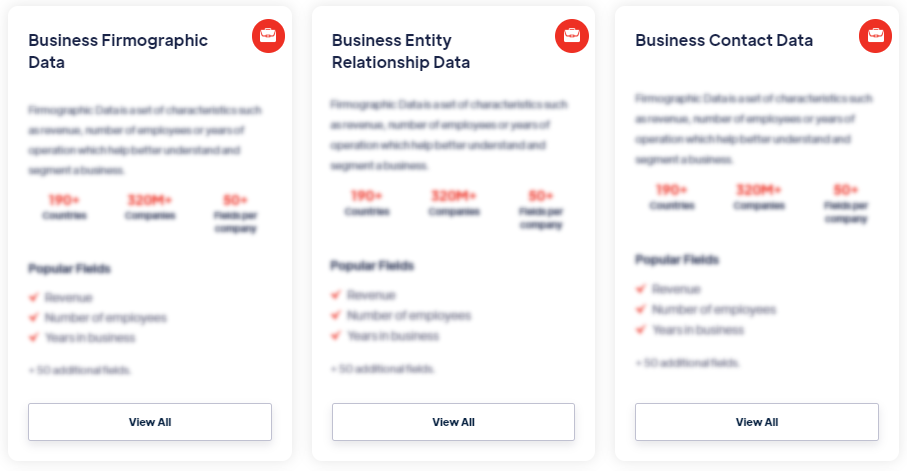Best
Electric Grid Data
Products
Electric Grid Data refers to the collection of data related to the operation, management, and performance of an electrical grid. It encompasses various data points associated with power generation, transmission, distribution, consumption, and grid infrastructure. Read more
Our Data Integrations


Request Data Sample for
Electric Grid Data

Browse the Data Marketplace

Frequently Asked Questions
1. What is Electric Grid Data?
Electric
Grid Data refers to the collection of data related to the
operation, management, and performance of an electrical grid. It
encompasses various data points associated with power
generation, transmission, distribution, consumption, and grid
infrastructure.
2. What types of information are included in Electric Grid
Data?
Electric Grid Data includes a wide range of information. It
includes data on power generation, such as the type of power
plants, their capacity, and energy output. Transmission data
includes details about the high-voltage transmission lines,
substations, and interconnections that transport electricity
across different regions. Distribution data includes information
on local distribution networks, transformers, and metering
infrastructure. Consumption data covers electricity usage
patterns, load profiles, and demand forecasts. Grid
infrastructure data includes information about grid equipment,
such as transformers, switchgear, and monitoring devices. It may
also include weather data, grid maintenance records, and
operational data from power system operators.
3. How is Electric Grid Data collected?
Electric Grid Data is collected through various sources and
methods. Power generation data is typically collected from power
plants and renewable energy installations through real-time
monitoring systems, remote sensing technologies, and data
loggers. Transmission data is collected from grid operators and
utilities through supervisory control and data acquisition
(SCADA) systems and network monitoring tools. Distribution data
is collected from utility companies, smart meters, and grid
sensors installed in distribution infrastructure. Consumption
data is collected from utility billing systems, smart meters,
and surveys conducted among consumers. Grid infrastructure data
is collected through inspections, maintenance records, and
monitoring systems deployed in the grid infrastructure. Weather
data may be collected from meteorological stations or weather
forecasting services.
4. How is Electric Grid Data used?
Electric Grid Data serves various purposes and is used by
different stakeholders. Grid operators and utilities use the
data to monitor grid performance, identify operational issues,
and optimize grid efficiency. Power generation companies use the
data to monitor power plant performance, plan maintenance
activities, and optimize generation schedules. Energy analysts
and researchers use the data to study electricity consumption
patterns, demand forecasting, and grid reliability.
Policy-makers and regulators use the data to develop energy
policies, evaluate the impact of renewable energy integration,
and plan for grid expansion and modernization. Consumers can
also access their consumption data to monitor their energy usage
and make informed decisions about energy conservation.
5. What are the challenges in working with Electric Grid
Data?
Working with Electric Grid Data presents several challenges.
One challenge is the diversity and heterogeneity of data
sources, formats, and systems used by different grid
stakeholders, which can hinder data integration and
interoperability. Another challenge is the volume and velocity
of data generated by the grid, requiring efficient data storage,
processing, and analysis capabilities. Data privacy and security
are critical, as Electric Grid Data may contain sensitive
information about energy consumption, infrastructure
vulnerabilities, and grid operations. Ensuring data quality and
accuracy is essential, as errors or inconsistencies can have
significant implications for grid management and
decision-making. Lastly, regulatory and policy considerations
can impact data access, sharing, and use, requiring adherence to
legal and compliance requirements.
6. What are the benefits of using Electric Grid Data?
Using Electric Grid Data offers several benefits. It enables
grid operators and utilities to monitor and manage grid
performance, optimize energy generation and distribution, and
detect and respond to grid disturbances and outages. Energy
analysts and researchers can gain insights into electricity
consumption patterns, load profiles, and demand forecasting,
aiding in the development of efficient energy management
strategies. Policy-makers and regulators can use the data to
formulate evidence-based energy policies, promote renewable
energy integration, and plan for a resilient and sustainable
grid infrastructure. Consumers can access their consumption data
to understand their energy usage, identify energy-saving
opportunities, and make informed decisions about their
electricity consumption.
7. What are the best practices for using Electric Grid
Data?
To effectively use Electric Grid Data, it is important to
follow best practices. This includes implementing data
governance frameworks to ensure data quality, integrity, and
privacy. Standardizing data formats, definitions, and protocols
promotes data interoperability and facilitates data sharing and
analysis among different stakeholders. Implementing robust data
management and analytics platforms enables efficient data
storage, processing, and analysis to derive meaningful insights.
Enhancing data security measures safeguards sensitive grid
information from unauthorized access and cyber threats.
Collaborating among grid operators, utilities, researchers, and
policy-makers fosters data sharing, knowledge exchange, and
innovation in the field of electric grid data.
